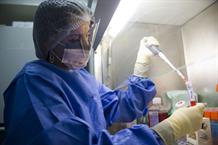The Life Sciences Division (Direction des sciences du vivant - DSV) benefits from its fundamental research and skills (chemistry, isotopic labeling, imaging, etc.) to propose innovative approaches in the areas of diagnosis, therapy and prophylaxis. These innovations must contribute to the development of personalized medicine, by allowing physicians to anticipate managing diseases, to avoid ineffective treatments for some patients, and to have more easily tolerated therapies at their disposal.
Diagnostic innovation
Diagnosing in a more sensitive, rapid and specific manner is one of the keys to caring for patients as efficiently as possible. To achieve this, DSV teams are developing innovative strategies by capitalizing on their expertise in various fields:
Detection tools: researchers develop and optimize new formats of immuno-analytical assays, potentially up until reaching industry
Large-scale biology: the methods of genomics, proteomics and metabolomics are used to identify new diagnostic biomarkers (including genes, proteins, and specific metabolic reactions in a pathological process)
magery: multidisciplinary teams work to develop better performing biotracers and contrast agents that are more specific for current PET or MRI instruments, or conceive new instruments (and associated software) with greater resolution (but less expensive)
DSV innovations in the fight against bioterrorism
As part of the interministerial program NRBC (Nuclear, Radiological, Biological and Chemical threats), DSV teams are developing tests for toxins or pathogens considered as potential bioterrorism threats, as well as prophylactic means in case of attack. Vaccine innovation
Classical vaccination, which uses an attenuated or inactive form of a pathogenic agent to trigger a specific immune response, is not successful for many serious infectious diseases including AIDS, hepatitis C, tuberculosis, and chikungunya. Combined expertise in immunology, engineering proteins and gene therapy allows the design of new vaccine strategies against these diseases, such as DNA vaccines (or gene vaccines), peptide vaccines, and protein vaccines.
These approaches are also of interest to the development of therapeutic vaccines, especially for cancer.

DSV researchers working on pathogenic
agents such as prions or the AIDS virus use analytical tools and imaging in laboratories located within biosafety level 3 confined environments.
©P.Stroppa/CEA
Therapeutic innovation
Finding a new treatment consists in developing a new therapeutic agent or a new mode of administration, as well as identifying a new therapeutic target. Subsequently, the effectiveness and safety of the new therapy should be evaluated.
There are many stages in which DSV researchers are involved in increasing these approaches. Some implement a pharmacological approach based on techniques of high-throughput screening of biological or chemical molecules, or even on large-scale biology. Others are involved in the fields of gene therapy or cell therapy.
Translational research
Translational research (or transfer research) establishes links between basic and clinical research, and helps accelerate the transition from one to the other by promoting exchanges. The imaging and preclinical research platform MIRCen (CEA-I2BM) is integrated in this process, thanks to predictive animal models of human diseases, non-invasive exploratory modes that are directly transferable to humans (e.g. medical imaging or cognitive tests), and close collaborations with hospitals. There are many stages in which DSV researchers are involved in increasing these approaches. Some implement a pharmacological approach based on techniques of high-throughput screening of biological or chemical molecules, or even on large-scale biology. Others are involved in the fields of gene therapy or cell therapy.
Patients suffering from neurodegenerative diseases (i.e. Alzheimer’s, Parkinson’s, or Huntington’s disease), neuroinflammatory diseases (multiple sclerosis), and cardiovascular or metabolic diseases, as well as genetic diseases (beta-thalassemia) will benefit from these therapeutic innovations.
To facilitate development and accelerate their arrival on the market, health technologies are brought to the CEA through a transversal program for all operational sectors (the Divisions of Life Sciences, Material Sciences, Technological Research, Nuclear Energy, and Military Applications). This transveral program, “Technologies for Health”, identifies ideas with strong economic potential and assists in the proof of concept and production of prototypes. This is a key step in the processes of development and transfer towards companies. The CEA is also involved in the Aviesan alliance’s ITMO (institut thématique multi-organismes), “Technologies pour la santé”.
The DSV directs three “National Infrastructures in Biology and Health” in the field of diagnostic, therapeutic and vaccine innovation :
IDMIT: National center for infectious diseases models and innovative therapies.
NeurATRIS, for translational research on biotherapies in the neurosciences.
FLI: France Life Imaging, in the field of medical imaging